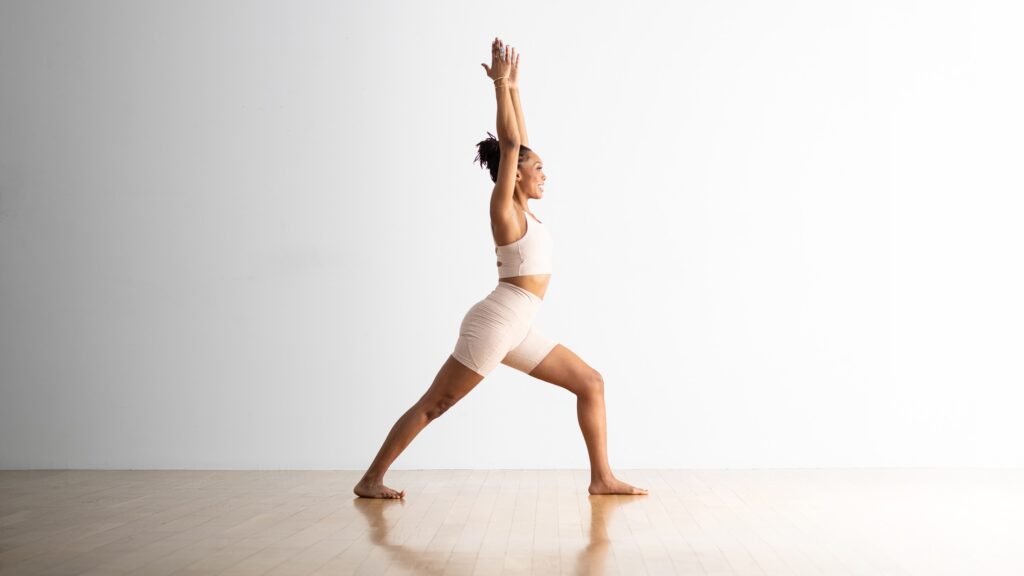“], “filter”: { “nextExceptions”: “img, blockquote, div”, “nextContainsExceptions”: “img, blockquote, a.btn, a.o-button”} }”>
Calling all desk-sitters: All that sedentary time staring at a screen is a significant contributor to the nagging lower backache that’s been annoying you. This is probably nothing you haven’t heard before, but did you know it might not be your back that’s actually the issue? It’s your hip flexors.
When you sit, your hip flexors remain in a contracted state. Prolonged sitting can cause these muscles to shorten and shrink, limiting your ability to lengthen the muscles and fully straighten at your hips when you’re finally upright again. So, what are you to do? Yoga, of course. You can use your practice to offset the effects of all that sitting, stretch your hip flexors, and relieve associated back pain.
Anatomy of Your Hip Flexors
Several hip flexor muscles cross the front of the hip and create hip flexion when they contract by pulling the thighs and chest toward each other. Probably the most important hip flexor is the iliopsoas. It is actually composed of two deep muscles: the iliacus and the psoas.
The psoas runs alongside the spine and attaches to the sides of the lumbar vertebrae. The iliacus originates on the inner bowl of the pelvis. Both muscles cross the floor of the pelvis and insert on the inner upper femur (thigh bone). Because the muscles are buried so deep, it’s easy to understand why there can be confusion about their location and role in everyday life. But these muscles are extremely important when it comes to ensuring your stability, balance, postural alignment, and full range of motion.
When you stand, the hip flexors contract as you lift your leg when you walk, run, come into a lunge, step up stairs, and so many other movements. When you are lying flat on your back, the hip flexors can either lift your leg, like when you draw your knees toward your chest, or lift your chest into a sit-up. In yoga, Boat Pose (Navasana) is especially effective for strengthening the iliopsoas because it demands that the muscle isometrically contract to hold the weight of the legs and upper body.

How Hip Flexors Lose Flexibility
Most problems with the hip flexors don’t originate in a lack of strength but in a lack of flexibility. To understand how these muscles lose their flexibility, imagine someone with a broken arm whose bent elbow is encased in a plaster cast. When the cast is removed after several weeks, the muscles, tendons, ligaments, and even skin around the elbow will have shortened, and the elbow won’t immediately straighten. It will take the patient several weeks of stretching to restore the full range of motion.
Similarly, if the hip is constantly kept in a flexed position, such as with prolonged sitting, the hip flexors will shorten and shrink, limiting your ability to fully extend your hip.
Issues Caused by Tight Hip Flexors
If the iliopsoas and other hip flexors are tight, they pull down and forward on the pelvis, which tilts the pelvis forward and compresses the lower back. Picture a man standing with the front of his pelvis tilting forward and his tailbone lifting. To stand upright, he has to overarch his lower back. Anatomically, this is called hyperextension; commonly, it’s called “swayback.” Prolonged standing or sitting in this position increases pressure on the facet joints of the lower spine, which in turn can contribute to arthritis in those joints.
With the best of intentions, yoga students sometimes create a muscle imbalance that contributes to this troublesome anterior (forward) pelvic tilt. Most yoga practitioners work long and hard to improve their hamstring flexibility but spend much less time stretching their hip flexors.
Eventually, the hamstrings lengthen significantly, while the hip flexors improve only slightly. The result: The relatively tighter hip flexors tip the pelvis forward because the relatively longer hamstrings no longer exert an equal counterpull on the sitting bones of the pelvis.
If the hip flexors are tight, the resulting anterior pelvic tilt and lumbar hyperextension can cause problems in addition to back pain, including difficulty in standing yoga poses such as Warrior 2 (Virabhadrasana II) and Triangle Pose (Trikonasana), in which the primary leg action is opening to the sides instead of flexing forward or extending back.
Tight hip flexors can also create challenges in poses requiring full extension (straightening) of the hip joint. These poses include backbends such as Bridge Pose (Setu Bandha Sarvangasana) and Upward-Facing Bow Pose (Urdhva Dhanurasana) and standing poses like Warrior 1 (Virabhadrasana I) and Warrior 3 (Virabhadrasana III)). In all of these poses, tight hip flexors can cause painful compression in the lower back.
4 Best Hip Flexor Stretches to Relieve Pain
Regularly practicing hip flexor stretches is important to counterbalance the prolonged hip flexion of sitting for hours.

1. Warrior 1 (Virabhadrasana I)
Warrior Pose 1 can be a hip flexor stretch. As you’re standing with one leg forward and one leg back, place your fingers on the front pelvis bones. You should be able to feel a small, round protuberance on each side, called the anterior superior iliac spine, or ASIS.
The ASISes are good indicators of the tilt of the pelvis. On the back leg, the iliopsoas will try to pull the pelvis and lumbar spine down and forward into an anterior tilt. To counter this, use your fingers to lift the ASISes. Hold this as you bend your front knee, keeping your back knee straight and your back heel grounded. Feel the iliopsoas lengthen and visualize the spine lifting out of the pelvis.
You can also work with the pelvic alignment in Warrior 1 by bringing your awareness to your lower back and the back of your pelvis. Hold or strap or belt around your waist. As you move into Warrior 1, don’t let your ASISes drop down and forward. Instead, move your back into the belt, move your tailbone down away from the belt, and lift your spine out of the belt. The belt becomes a point of orientation to help you align your pelvis and get a deep iliopsoas stretch.
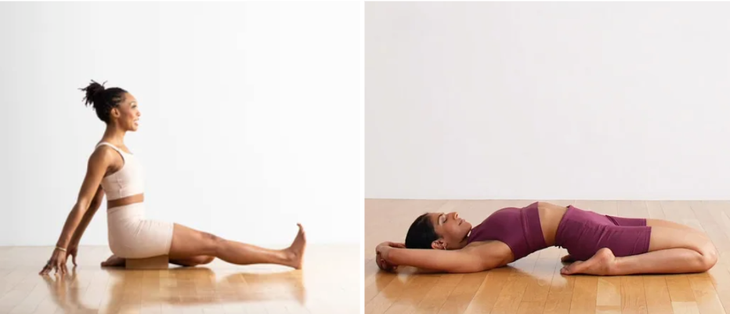
2. Full or Half Reclining Hero Pose (Supta Virasana)
Another hip flexor muscle is the rectus femoris. When it’s tight, it can limit hip flexion and cause problems in yoga poses. It’s one of the quadriceps muscle on the front of the thigh and it originates near the ASIS, runs down the center of the thigh, and inserts on the shinbone (tibia) just below the knee. When the rectus femoris contracts and shortens, it not only extends or straightens the knee, it also flexes the hip.
To stretch the rectus femoris, you need a pose that flexes the knee and extends the hip, like Reclining Hero Pose. As you sit down between your heels and lie back in this pose, the rectus femoris lengthens.
To stretch the rectus femoris without compressing the lower back, place a bolster or folded blankets comfortably under your back. You can also do Half Reclining Hero Pose, in which you sit up with one leg bent and the other leg extended straight in front of you. You can sit on a bolster, block, or folded blanket to allow more space.
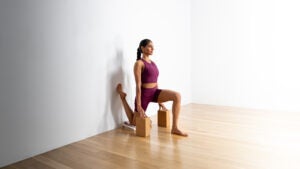
3. King Arthur’s Pose
This pose draws on the same alignment as Warrior 1 but while kneeling so there’s less demand on the muscles to stabilize you as you’re stretching.
As you come into a Low Lunge facing away from a wall, place your back foot against the wall. Place your hands on your front knee and straighten your spine straight up while allowing your tailbone to release down. You should feel a strong stretch along the front of your left thigh.
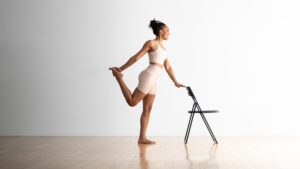
You can take a folded blanket beneath your knee for cushioning or practice the same pose standing by placing your hand on a chair, counter, or wall and bending one leg behind you and grasping it with your hand or a strap.
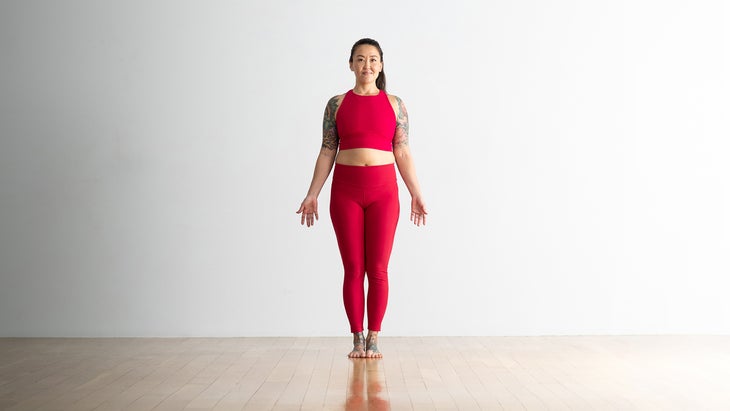
4. Mountain Pose (Tadasana)
If you tend to stand with a swayback, or an exaggerated curve in your lower back also known as lordosis, developing awareness of your hip flexors is especially important.
In Mountain Pose (Tadasana), practice lifting the ASISes, subtly shifting your tailbone down, and lifting your lumbar spine. Placing a belt or strap around your waist, as you did in Warrior 1, may help increase your awareness of your pelvic alignment in this pose.
Often people try to correct a forward tilt of the pelvis by engaging their abdominal muscles. But gripping your abdominals won’t control the anterior pelvic tilt if you have tight hip flexors—not even in simple standing postures. It also tends to constrict your breath.
Practicing hip flexor stretches, especially after a long day of sitting, can help you find space in your pelvis—and help protect you from compression and pain in your lower back.
This article has been updated. Originally published June 29, 2021.

